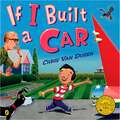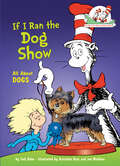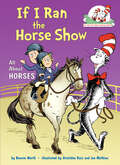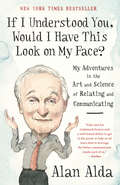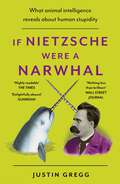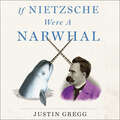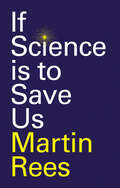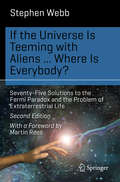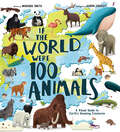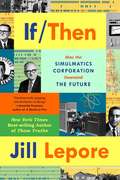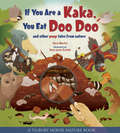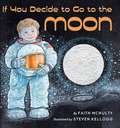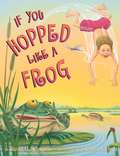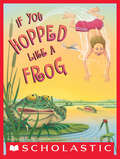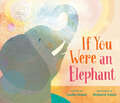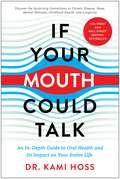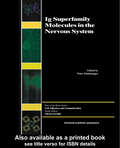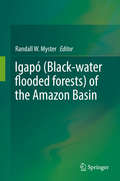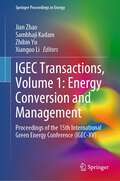- Table View
- List View
If I Built a Car (If I Built Series)
by Chris Van DusenIf I built a car, it'd be totally new!Here are a few of the things that I'd do. . . .Young Jack is giving an eye-opening tour of the car he'd like to build. There's a snack bar, a pool, and even a robot named Robert to act as chauffeur. With Jack's soaring imagination in the driver's seat, we're deep-sea diving one minute and flying high above traffic the next in this whimsical, tantalizing take on the car of the future. Illustrations packed with witty detail, bright colors, and chrome recall the fabulous fifties and an era of classic American automobiles. Infectious rhythm and clever invention make this wonderful read-aloud a launch pad for imaginative fun.
If I Ran the Dog Show: All About Dogs (The Cat in the Hat's Learning Library)
by Tish RabeLaugh and learn with fun facts about humankind&’s best friend—dogs!—all told in Dr. Seuss&’s beloved rhyming style and starring The Cat in the Hat. &“I&’m the Cat in the Hat, and today we will go to the Short-Shaggy-Tail-Waggy Super Dog Show!&” The Cat in the Hat&’s Learning Library series combines beloved characters, engaging rhymes, and Seussian illustrations to introduce children to non-fiction topics from the real world! In this doggone fun book, readers will learn about: • the wide variety of dog breeds• their amazing bodies and senses• the growth stages of puppies• and much more! Perfect for story time and for the youngest readers, If I Ran the Dog Show also includes an index, glossary, and suggestions for further learning. Look for more books in the Cat in the Hat&’s Learning Library series!Cows Can Moo! Can You? All About FarmsHark! A Shark! All About SharksOh Say Can You Say Di-no-saur? All About DinosaursOn Beyond Bugs! All About InsectsOne Vote Two Votes I Vote You VoteThere&’s No Place Like Space: All About Our Solar SystemWho Hatches the Egg? All About EggsWhy Oh Why Are Deserts Dry? All About DesertsWish for a Fish: All About Sea Creatures
If I Ran the Horse Show: All About Horses (Cat in the Hat's Learning Library)
by Bonnie WorthCalling all young equestrians and Cat (in the Hat) fanciers! In this latest installment of the Cat in the Hat's Learning Library, the Cat introduces Sally and Nick—and beginning readers—to all things horsey. At his Super-Tremendous-Stupendous Horse Show, the Cat explains how horses and people have worked together since ancient times; the difference between fillies, foals, yearlings, mares, colts, dams, sires, and stallions; horse anatomy from nose to tail; the work of a farrier, Western vs English riding; and much, much more—including fun facts about 13 of the most popular horse breeds! Fans of the new PBS Kids preschool science show the Cat in the Hat Knows a Lot About That! (which is based on The Cat in the Hat's Learning Library) will whinny with glee over this new addition to the series!
If I Understood You, Would I Have This Look on My Face?: My Adventures in the Art and Science of Relating and Communicating
by Alan Alda<P>Alan Alda, the award-winning actor and bestselling author, tells us the fascinating story of his quest to learn how to communicate better, and to teach others to do the same. With his trademark humor and candor, he explores how to develop empathy as the key factor. Alan Alda has been on a decades-long journey to discover new ways to help people communicate and relate to one another more effectively. <P>If I Understood You, Would I Have This Look on My Face? is the warm, witty, and informative chronicle of how Alda found inspiration in everything from cutting-edge science to classic acting methods. His search began when he was host of PBS’s Scientific American Frontiers, where he interviewed thousands of scientists and developed a knack for helping them communicate complex ideas in ways a wide audience could understand—and Alda wondered if those techniques held a clue to better communication for the rest of us. <P>In his wry and wise voice, Alda reflects on moments of miscommunication in his own life, when an absence of understanding resulted in problems both big and small. He guides us through his discoveries, showing how communication can be improved through learning to relate to the other person: listening with our eyes, looking for clues in another’s face, using the power of a compelling story, avoiding jargon, and reading another person so well that you become “in sync” with them, and know what they are thinking and feeling—especially when you’re talking about the hard stuff. <P>Drawing on improvisation training, theater, and storytelling techniques from a life of acting, and with insights from recent scientific studies, Alda describes ways we can build empathy, nurture our innate mind-reading abilities, and improve the way we relate and talk with others. Exploring empathy-boosting games and exercises, If I Understood You is a funny, thought-provoking guide that can be used by all of us, in every aspect of our lives—with our friends, lovers, and families, with our doctors, in business settings, and beyond. <P><b>A New York Times Bestseller</b>
If Nietzsche Were a Narwhal: What Animal Intelligence Reveals About Human Stupidity
by Justin GreggWhat if human intelligence is actually more of a liability than a gift? After all, the animal kingdom, in all its diversity, gets by just fine without it. At first glance, human history is full of remarkable feats of intelligence, yet human exceptionalism can be a double-edged sword. With our unique cognitive prowess comes severe consequences, including existential angst, violence, discrimination, and the creation of a world teetering towards climate catastrophe. What if human exceptionalism is more of a curse than a blessing?As Justin Gregg puts it, there's an evolutionary reason why human intelligence isn't more prevalent in the animal kingdom. Simply put, non-human animals don't need it to be successful. And, miraculously, their success arrives without the added baggage of destroying themselves and the planet in the process.In seven mind-bending and hilarious chapters, Gregg highlights features seemingly unique to humans - our use of language, our rationality, our moral systems, our so-called sophisticated consciousness - and compares them to our animal brethren. What emerges is both demystifying and remarkable, and will change how you look at animals, humans, and the meaning of life itself.
If Nietzsche Were a Narwhal: What Animal Intelligence Reveals About Human Stupidity
by Justin GreggA MYTH-BUSTING EXPOSÉ OF HOW HUMAN INTELLIGENCE MAY BE MORE A LIABILITY THAN A GIFT AND A REFRESHING NEW WAY TO UNDERSTAND THE ANIMAL KINGDOM AND OUR PLACE ON EARTH.What if human intelligence is actually more of a liability than a gift? After all, the animal kingdom, in all its diversity, gets by just fine without it. At first glance, human history is full of remarkable feats of intelligence, yet human exceptionalism can be a double-edged sword. With our unique cognitive prowess comes severe consequences, including existential angst, violence, discrimination, and the creation of a world teetering towards climate catastrophe. What if human exceptionalism is more of a curse than a blessing?As Justin Gregg puts it, there's an evolutionary reason why human intelligence isn't more prevalent in the animal kingdom. Simply put, non-human animals don't need it to be successful. And, miraculously, their success arrives without the added baggage of destroying themselves and the planet in the process.In seven mind-bending and hilarious chapters, Gregg highlights features seemingly unique to humans - our use of language, our rationality, our moral systems, our so-called sophisticated consciousness - and compares them to our animal brethren. What emerges is both demystifying and remarkable, and will change how you look at animals, humans, and the meaning of life itself.(P) 2022 Hachette Audio
If Our Bodies Could Talk: A Guide to Operating and Maintaining a Human Body
by James Hamblin"If you want to understand the strange workings of the human body, and the future of medicine, you must read this illuminating, engaging book." —Siddhartha Mukherjee, author of The Gene In 2014, James Hamblin launched a series of videos for The Atlantic called "If Our Bodies Could Talk." With it, the doctor-turned-journalist established himself as a seriously entertaining authority in the field of health. Now, in illuminating and genuinely funny prose, Hamblin explores the human stories behind health questions that never seem to go away—and which tend to be mischaracterized and oversimplified by marketing and news media. He covers topics such as sleep, aging, diet, and much more: • Can I “boost” my immune system? • Does caffeine make me live longer? • Do we still not know if cell phones cause cancer? • How much sleep do I actually need? • Is there any harm in taking a multivitamin? • Is life long enough? In considering these questions, Hamblin draws from his own medical training as well from hundreds of interviews with distinguished scientists and medical practitioners. He translates the (traditionally boring) textbook of human anatomy and physiology into accessible, engaging, socially contextualized, up-to-the-moment answers. They offer clarity, examine the limits of our certainty, and ultimately help readers worry less about things that don’t really matter. If Our Bodies Could Talk is a comprehensive, illustrated guide that entertains and educates in equal doses.From the Hardcover edition.
If Science is to Save Us
by Martin ReesThere has never been a time when &‘following the science&’ has been more important for humanity. At no other point in history have we had such advanced knowledge and technology at our fingertips, nor had such astonishing capacity to determine the future of our planet. But the decisions we must make on how science is applied belong outside the lab and should be the outcome of wide public debate. For that to happen, science needs to become part of our common culture. Science is not just for scientists: if it were, it could never save us from the multiple crises we face. For science can save us, if its innovations mesh carefully into society and its applications are channelled for the common good. As Martin Rees argues in this expert and personal analysis of the scientific endeavour on which we all depend, we need to think globally, we need to think rationally and we need to think long-term, empowered by twenty-first-century technology but guided by values that science alone cannot provide.
If the Universe Is Teeming with Aliens ... WHERE IS EVERYBODY?
by Stephen WebbGiven the fact that there are perhaps 400 billion stars in our Galaxy alone, and perhaps 400 billion galaxies in the Universe, it stands to reason that somewhere out there, in the 14-billion-year-old cosmos, there is or once was a civilization at least as advanced as our own. The sheer enormity of the numbers almost demands that we accept the truth of this hypothesis. Why, then, have we encountered no evidence, no messages, no artifacts of these extraterrestrials? In this second, significantly revised and expanded edition of his widely popular book, Webb discusses in detail the (for now!) 75 most cogent and intriguing solutions to Fermi's famous paradox: If the numbers strongly point to the existence of extraterrestrial civilizations, why have we found no evidence of them? Reviews from the first edition: "Amidst the plethora of books that treat the possibility of extraterrestrial intelligence, this one by Webb . . . is outstanding. . . . Each solution is presented in a very logical, interesting, thorough manner with accompanying explanations and notes that the intelligent layperson can understand. Webb digs into the issues . . . by considering a very broad set of in-depth solutions that he addresses through an interesting and challenging mode of presentation that stretches the mind. . . . An excellent book for anyone who has ever asked 'Are we alone?'. " (W. E. Howard III, Choice, March, 2003) "Fifty ideas are presented . . . that reveal a clearly reasoned examination of what is known as 'The Fermi Paradox'. . . . For anyone who enjoys a good detective story, or using their thinking faculties and stretching the imagination to the limits . . . 'Where is everybody' will be enormously informative and entertaining. . . . Read this book, and whatever your views are about life elsewhere in the Universe, your appreciation for how special life is here on Earth will be enhanced! A worthy addition to any personal library. " (Philip Bridle, BBC Radio, March, 2003) Since gaining a BSc in physics from the University of Bristol and a PhD in theoretical physics from the University of Manchester, Stephen Webb has worked in a variety of universities in the UK. He is a regular contributor to the Yearbook of Astronomy series and has published an undergraduate textbook on distance determination in astronomy and cosmology as well as several popular science books. His interest in the Fermi paradox combines lifelong interests in both science and science fiction.
If the World Were 100 Animals: A Visual Guide to Earth's Amazing Creatures
by Miranda SmithHelp your child understand the creatures that share our world and how we can protect them with these big ideas expressed through bite-size chunks of information and eye-opening graphics. This fascinating companion to If the World Were 100 People is perfect for home and classroom settings!With around 20 quintillion animals on Earth, it's impossible to know everything about them all! However, if we shrink that number down to 100, we can picture a global park that lets us learn about our fellow living creatures. An accessible introduction to our planet's creatures, perfect for fact-hungry animal lovers!
If Then: How Simulmatics Corporation Invented The Future
by Jill LeporeLonglisted • Financial Times & McKinsey Business Book of the Year A revelatory account of the Cold War origins of the data-mad, algorithmic twenty-first century, from the author of the acclaimed international bestseller These Truths. The Simulmatics Corporation, launched during the Cold War, mined data, targeted voters, manipulated consumers, destabilized politics, and disordered knowledge—decades before Facebook, Google, and Cambridge Analytica. Jill Lepore, best-selling author of These Truths, came across the company’s papers in MIT’s archives and set out to tell this forgotten history, the long-lost backstory to the methods, and the arrogance, of Silicon Valley. Founded in 1959 by some of the nation’s leading social scientists—“the best and the brightest, fatally brilliant, Icaruses with wings of feathers and wax, flying to the sun”—Simulmatics proposed to predict and manipulate the future by way of the computer simulation of human behavior. In summers, with their wives and children in tow, the company’s scientists met on the beach in Long Island under a geodesic, honeycombed dome, where they built a “People Machine” that aimed to model everything from buying a dishwasher to counterinsurgency to casting a vote. Deploying their “People Machine” from New York, Washington, Cambridge, and even Saigon, Simulmatics’ clients included the John F. Kennedy presidential campaign, the New York Times, the Department of Defense, and dozens of major manufacturers: Simulmatics had a hand in everything from political races to the Vietnam War to the Johnson administration’s ill-fated attempt to predict race riots. The company’s collapse was almost as rapid as its ascent, a collapse that involved failed marriages, a suspicious death, and bankruptcy. Exposed for false claims, and even accused of war crimes, it closed its doors in 1970 and all but vanished. Until Lepore came across the records of its remains. The scientists of Simulmatics believed they had invented “the A-bomb of the social sciences.” They did not predict that it would take decades to detonate, like a long-buried grenade. But, in the early years of the twenty-first century, that bomb did detonate, creating a world in which corporations collect data and model behavior and target messages about the most ordinary of decisions, leaving people all over the world, long before the global pandemic, crushed by feelings of helplessness. This history has a past; If Then is its cautionary tale.
If You Are A Kaka, You Eat Doo Doo: And Other Poop Tales From Nature (Tilbury House Nature Book #0)
by Sara Lynn Cramb Sara MartelWombat poos are box-shaped to stay where they're deposited and serve as messages to other animals. Baby golden tortoise beetles pile poop on their backs to create a shield as protection from predators. Silver-spotted skipper caterpillars can shoot their poops 40 times their own body length to conceal their true locations. Baby hoopoes squirt their poops into the eyes of attackers, and who wants feces in their faces? Baby Ozark blind cave salamanders use gray bat guano for food. The bottom (!!) line: Ever-inventive Nature finds a thousand uses for poop. Nothing goes to waste (!!). This book is a guaranteed crowd-pleaser with a lot of information to share.
If You Decide to Go to the Moon
by Faith McNulty Steven Kellogg"If you decide to go to the moon," writes Faith McNulty, "read this book first. It will tell you how to get there and what to do after you land. The most important part tells you how to get home." Written in the second person, the text allows the reader to participate in every aspect of the journey, from packing ("don't forget your diary and plenty of food") to liftoff (at first you'll feel heavy; don't worry") to traveling through space (where "the moon glows like a pearl in the black, black sky"). The reader lands at the Sea of Tranquility, the site of the first lunar landing
If You Hopped like a Frog
by David M. SchwartzDid you know that a frog can jump 29 times its body length? Or that an ant can lift an object 50 times its weight?
If You Hopped Like A Frog (If You... Ser.)
by David M. SchwartzHow far could you hop?If you hopped like a frog...you could jump from home plate to first base in one mighty leap!Did you know that a frog can jump 20 times its body length? Or that an ant can lift an object 50 times its own weight?Read this book and find out what you could do -- if you had the amazing abilities of animals! And there are endless possibilities for making more hilarious comparisons of your own. Get ready for ratio and proportion like you've never seen them before!
If You Love This Planet: A Plan to Save the Earth (Revised and updated)
by Helen Caldicott"Helen Caldicott has the rare ability to combine science with passion, logic with love, and urgency with humor." --Naomi Klein From the leader and spokeswoman of the antinuclear movement comes a revised and updated edition of this groundbreaking, widely acclaimed classic. Exploring dangerous global trends such as ozone depletion, global warming, toxic pollution, food contamination, and deforestation, Helen Caldicott presents a picture of our world and the forces that threaten its existence. As always, she gives a prescription for a cure and cause for hope, rallying readers to action with the contention that our fight for the planet will draw its strength from love for the Earth itself.
If You Tame Me: Understanding Our Connection with Animals
by Leslie IrvineNearly everyone who cares about them believes that dogs and cats have a sense of self that renders them unique. Traditional science and philosophy declare such notions about our pets to be irrational and anthropomorphic. Animals, they say, have only the crudest form of thought and no sense of self at all. Leslie Irvine's If You Tame Me challenges these entrenched views by demonstrating that our experience of animals and their behavior tells a different story. Dogs and cats have been significant elements in human history and valued members of our households for centuries. Why do we regard these companions as having distinct personalities and as being irreplaceable? Leslie Irvine looks closely at how people form "connections" with dogs and cats available in adoption shelters and reflects on her own relationships with animals. If You Tame Me makes a persuasive case for the existence of a sense of self in companion animals and calls upon us to reconsider our rights and obligations regarding the non-human creatures in our lives.
If You Were an Elephant
by Leslie StaubA charming and exuberant nonfiction picture book about a young elephant's day on the savanna with her herd.If you were an elephant, you'd be the biggest animal who lives on the land. You'd have ears big as tent flaps, skin thick as blankets. You'd turn the next page with your trunk, not your hand. Chock-full of amazing facts, this joyful read aloud invites readers to follow in the (enormous) footsteps of one of the world's most remarkable creatures--from munching on bushes and branches all day, to splashing around in water holes and mud baths, to finally curling up with the herd in a pool of moonlight. Kids will love every moment of this playful introduction to the daily sights, sounds, and activities of a young elephant in the wild.
If Your Mouth Could Talk: An In-Depth Guide to Oral Health and Its Impact on Your Entire Life
by Kami HossUSA TODAY AND WALL STREET JOURNAL BESTSELLER You&’ve heard the advice: If you want to live longer, eat healthy foods and exercise daily. But there&’s a third piece of the puzzle, and it can add 10 to 15 years to your life. It&’s been right under your nose this whole time—literally. Your mouth is the gateway to your body and is the most critical organ for improving your health, from childhood onward. Everything in the human life cycle is related to the mouth: fertility, childbirth, sleeping soundly, success in school, finding a mate, getting a job, psychological well-being, avoiding chronic or systemic disease, and aging well. Your mouth is a window into the health of your body as a whole; from its microbiome to its structure, it impacts your physical and mental wellness in countless ways. Unfortunately, the mouth-body connection has been largely neglected by American medicine . . . until now. If Your Mouth Could Talk is the result of over 20 years of firsthand experience and research by renowned orthodontist and dentofacial orthopedist, Dr. Kami Hoss. In this groundbreaking work, Dr. Hoss connects the dots between oral health and whole-body health, offering a roadmap to a longer, more successful future for you and your family. This isn&’t a book about brushing and flossing—or any of the other standard advice you get from your dentist. Instead, you&’ll hear about how to protect your mouth&’s microbiome, the effect of diet, the relationship between oral structure and sleep problems, how to breathe better, and more. This is an in-depth guide for people who want to take control of their health to the fullest extent possible—who want to understand how their mouth contributes to their overall health and quality of life, and what they can do to better care for it. If your mouth could talk, it would tell you about the condition of your entire life. Time to start listening.
IFLScience 117 Things You Should F*#king Know About Your World
by Paul Parsons The Writers of IFLScienceIFLScience presents the most intriguing and far-out facts about space, technology, the human brain, nature, and so much more that you should know, right now!117 Things You Should F*#ing Know About Your World is a compendium of the greatest articles from IFLScience's long history, broken up by leading subjects: Health & Medicine Plants & Animals Technology The Brain Space The Environment Chemistry PhysicsEach chapter opens with a new and irreverent introduction to the subject and collection of stories by author Paul Parsons, and the book features fascinating sidebars on related stories, photos, and illustrations throughout.From pinpointing the exact worst time to be alive in human history, to learning what makes you a procrastinator or a go-getter, to the very key to a happy sex life, and so much more, this is the science book that only the world's leading source of crazy-but-true stories could produce.
Ig Superfamily Molecules in the Nervous System
by Peter SondereggerA vast number of neural cell surface glycoproteins belonging to the immunoglobulin superfamily have been isolated over the past two decades. In functional studies, many of them have been shown to confer adhesive properties to cells and to play an important role in developmental processes such as cell migration and axon outgrowth. Recent observation
Igapó (Black-water flooded forests) of the Amazon Basin
by Randall W. MysterIgapó forests are a common part of the Amazon whose ecosystems are critical to our shared human future. The introduction addresses the structure, function and dynamics of igapó forests in the Amazon basin, focusing on their uniqueness due to their high level of complexity defined as the many ways that different components of igapó forests in the Amazon basin ecosystem interact and also on how those interactions are on a higher-order compared to other tropical forests. The text then breaks down the igapó ecosystem using these sections: (1) Igapó forests over space and time, (2) Water, light and soils, (3) The carbon cycle, (4) Litter, fungi and invertebrates, (5) Vertebrates, (6) Plant population studies, (7) Plant community studies, and (8) Human impacts and management. Experts from around the world serve as chapter authors that review what is known about their specific part of the igapó ecosystem, what research they have done, and also what needs to be done in the future.
IgE Antibodies: Generation and Function
by Juan J. Lafaille Maria A. Curotto de LafailleThis volume examines all facets of the complex biology of Immunoglobulin E (IgE) antibodies, which play an essential role in the pathophysiology of allergic diseases and immunity to parasites. It highlights the unique mechanisms involved in the regulation of IgE production at both the molecular and cellular level. Furthermore, it discusses in detail novel findings on how the affinity, specificity and cross-reactivity of IgE can fine-tune mast cell responses to allergens. The book also explores the beneficial roles of IgE antibodies in immunity to helminthes and protection against tumors, and how the properties of IgE-mediated immunity are employed in the development of IgE therapeutic antibodies. All chapters were written by respected experts in their fields and will appeal to scientists and clinicians alike.
IGEC Transactions, Volume 1: Proceedings of the 15th International Green Energy Conference (IGEC-XV) (Springer Proceedings in Energy)
by Jian Zhao Sambhaji Kadam Zhibin Yu Xianguo LiThis book is the first volume of the proceedings of the 15th International Green Energy Conference (IGEC) held in Glasgow, UK from 10-13 July 2023. This meeting is the latest in a multi-disciplinary international conference series on the use of energy with no or reduced environmental, social, and economic impacts. The conference provided a platform for sharing new technical information, disseminating high-quality research results, presenting the latest developments in energy and environment, and debating the shaping of future directions and priorities for sustainable development and energy security.This conference proceedings is of particular value and interest to researchers, scientists, engineers, and practitioners from relevant fields of energy and environment, from policy-making and technical development to management and marketing.
iGenetics: A Mendelian Approach
by Peter J. RussellA Mendelian Approach reflects the dynamic nature of modern genetics by emphasizing an experimental, inquiry-based approach with a solid treatment of many research experiments.
